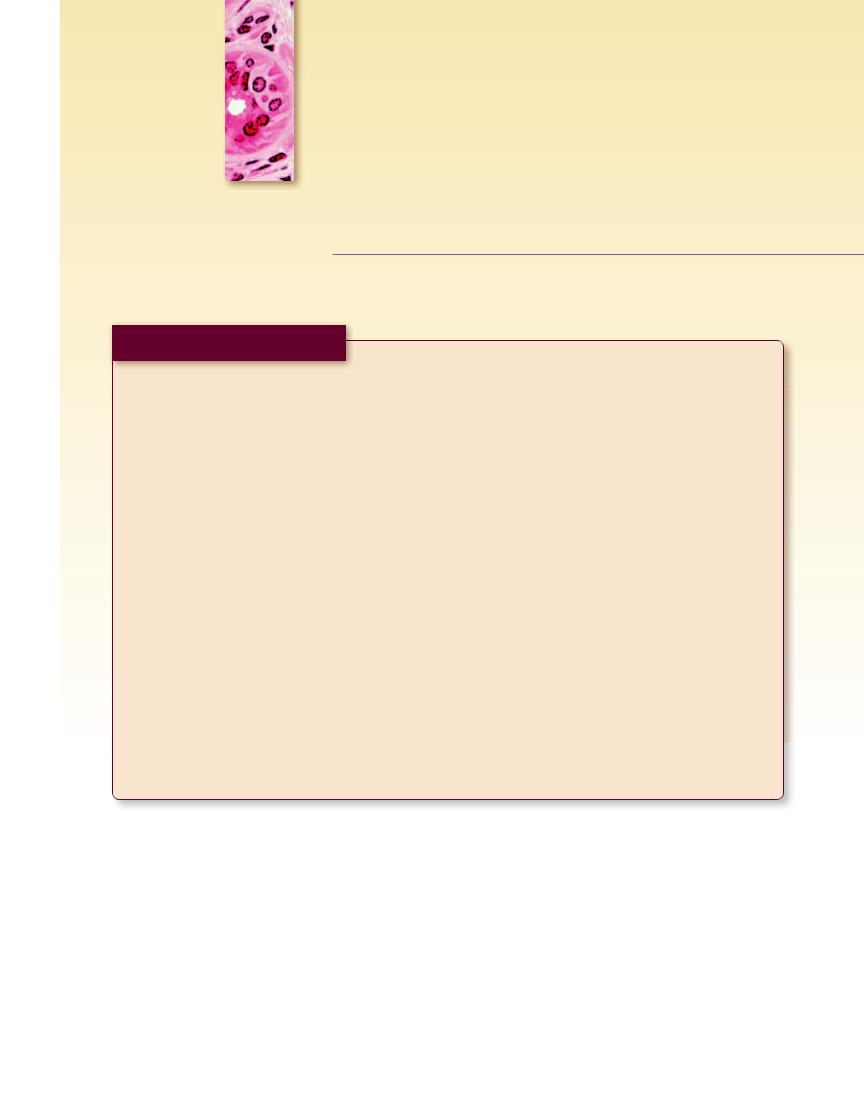
- •Preface
- •Acknowledgments
- •Reviewers
- •Contents
- •CHAPTER OUTLINE
- •CYTOPLASM
- •Plasmalemma
- •Mitochondria
- •Ribosomes
- •Endoplasmic Reticulum
- •Golgi Apparatus, cis-Golgi Network, and the trans-Golgi Network
- •Endosomes
- •Lysosomes
- •Peroxisomes
- •Proteasomes
- •Cytoskeleton
- •Inclusions
- •NUCLEUS
- •CELL CYCLE
- •CHAPTER OUTLINE
- •EPITHELIUM
- •Epithelial Membranes
- •GLANDS
- •Chapter Summary
- •CHAPTER OUTLINE
- •EXTRACELLULAR MATRIX
- •Fibers
- •Amorphous Ground Substance
- •Extracellular Fluid
- •CELLS
- •CONNECTIVE TISSUE TYPES
- •Chapter Summary
- •CHAPTER OUTLINE
- •CARTILAGE
- •BONE
- •Cells of Bone
- •Osteogenesis
- •Bone Remodeling
- •Chapter Summary
- •CHAPTER OUTLINE
- •FORMED ELEMENTS OF BLOOD
- •Lymphocytes
- •Neutrophils
- •PLASMA
- •COAGULATION
- •HEMOPOIESIS
- •Erythrocytic Series
- •Granulocytic Series
- •Chapter Summary
- •CHAPTER OUTLINE
- •SKELETAL MUSCLE
- •Sliding Filament Model of Muscle Contraction
- •CARDIAC MUSCLE
- •SMOOTH MUSCLE
- •Chapter Summary
- •CHAPTER OUTLINE
- •BLOOD-BRAIN BARRIER
- •NEURONS
- •Membrane Resting Potential
- •Action Potential
- •Myoneural Junctions
- •Neurotransmitter Substances
- •SUPPORTING CELLS
- •PERIPHERAL NERVES
- •Chapter Summary
- •CHAPTER OUTLINE
- •BLOOD VASCULAR SYSTEM
- •HEART
- •ARTERIES
- •Capillary Permeability
- •Endothelial Cell Functions
- •VEINS
- •LYMPH VASCULAR SYSTEM
- •Chapter Summary
- •CHAPTER OUTLINE
- •CELLS OF THE IMMUNE SYSTEM
- •Antigen-Presenting Cells
- •DIFFUSE LYMPHOID TISSUE
- •LYMPH NODES
- •TONSILS
- •SPLEEN
- •THYMUS
- •Chapter Summary
- •CHAPTER OUTLINE
- •PITUITARY GLAND
- •Pars Intermedia
- •Pars Nervosa and Infundibular Stalk
- •Pars Tuberalis
- •THYROID GLAND
- •Parathyroid Glands
- •Suprarenal Glands
- •Cortex
- •Medulla
- •Pineal Body
- •Chapter Summary
- •CHAPTER OUTLINE
- •SKIN
- •Epidermis of Thick Skin
- •Dermis
- •DERIVATIVES OF SKIN
- •Chapter Summary
- •CHAPTER OUTLINE
- •CONDUCTING PORTION OF THE RESPIRATORY SYSTEM
- •Extrapulmonary Region
- •Intrapulmonary Region
- •RESPIRATORY PORTION OF THE RESPIRATORY SYSTEM
- •MECHANISM OF RESPIRATION
- •Chapter Summary
- •CHAPTER OUTLINE
- •ORAL CAVITY AND ORAL MUCOSA
- •Oral Mucosa
- •Tongue
- •Teeth
- •Odontogenesis (See Graphic 13-2)
- •Chapter Summary
- •CHAPTER OUTLINE
- •REGIONS OF THE DIGESTIVE TRACT
- •Esophagus
- •Stomach
- •Small Intestine
- •Large Intestine
- •GUT-ASSOCIATED LYMPHOID TISSUE
- •DIGESTION AND ABSORPTION
- •Carbohydrates
- •Proteins
- •Lipids
- •Water and Ions
- •Chapter Summary
- •CHAPTER OUTLINE
- •MAJOR SALIVARY GLANDS
- •PANCREAS
- •LIVER
- •Exocrine Function of the Liver
- •Endocrine and Other Functions of the Liver
- •GALLBLADDER
- •Chapter Summary
- •CHAPTER OUTLINE
- •KIDNEY
- •Uriniferous Tubule
- •Nephron
- •Collecting Tubules
- •FORMATION OF URINE FROM ULTRAFILTRATE
- •EXTRARENAL EXCRETORY PASSAGES
- •Chapter Summary
- •CHAPTER OUTLINE
- •OVARY
- •Ovarian Follicles
- •Regulation of Follicle Maturation and Ovulation
- •Corpus Luteum and Corpus Albicans
- •GENITAL DUCTS
- •Oviduct
- •Uterus
- •FERTILIZATION, IMPLANTATION, AND THE PLACENTA
- •Fertilization and Implantation
- •Placenta
- •VAGINA
- •EXTERNAL GENITALIA
- •MAMMARY GLANDS
- •Chapter Summary
- •CHAPTER OUTLINE
- •TESTES
- •Spermatogenesis
- •GENITAL DUCTS
- •ACCESSORY GLANDS
- •PENIS
- •Erection and Ejaculation
- •Chapter Summary
- •CHAPTER OUTLINE
- •SENSORY ENDINGS
- •Chapter Summary
- •Terminology of Staining
- •Common Stains Used in Histology
- •Hematoxylin and Eosin
- •Wright Stain
- •Weigert Method for Elastic Fibers and Elastic van Gieson Stain
- •Silver Stain
- •Iron Hematoxylin
- •Bielschowsky Silver Stain
- •Masson Trichrome
- •Periodic Acid-Schiff Reaction (PAS)
- •Alcian Blue
- •von Kossa Stain
- •Sudan Red
- •Mucicarmine Stain
- •Safranin-O
- •Toluidine Blue

Chapter Summary
I. MAJOR SALIVARY GLANDS
Three major salivary glands are associated with the oral cavity. These are the parotid, submandibular, and sublingual glands.
A. Parotid Gland
The parotid gland is a purely serous compound tubuloalveolar gland whose capsule sends septa (frequently containing adipose cells) into the substance of the gland, dividing it into lobes and lobules. Serous acini, surrounded by myoepithelial cells, deliver their secretions into intercalated ducts.
B. Submandibular Gland
This compound tubuloalveolar gland is mostly serous, although it contains enough mucous units, capped by serous demilunes, to manufacture a mixed secretion. Acini are surrounded by myoepithelial (basket) cells. The capsule sends septa into the substance of the gland, subdividing it into lobes and lobules. The duct system is extensive.
C. Sublingual Gland
The sublingual gland is a compound tubuloalveolar gland whose capsule is not very definite. The gland produces a mixed secretion, possessing mostly mucous acini capped by serous demilunes and surrounded by myoepithelial (basket) cells. The intralobular duct system is not very extensive.
II. PANCREAS
The exocrine pancreas is a compound tubuloalveolar serous gland whose connective tissue capsule sends septa to divide the parenchyma into lobules. Acini present centroacinar cells, the beginning of the ducts that empty into intercalated ducts, which lead to intralobular, then interlobular ducts.The main duct receives secretory products from the interlobular ducts. The endocrine pancreas with its islets of Langerhans (composed of A, B, G, and D cells) are scattered among the serous acini.
III. LIVER
A. Capsule
Glisson’s capsule invests the liver and sends septa into the substance of the liver at the porta hepatis to subdivide the parenchyma into lobules.
B. Lobules
1. Classical Lobule
Classical lobules are hexagonal with portal areas (triads) at the periphery and a central vein in the center.Trabeculae (plates) of liver cells anastomose. Sinusoids are lined by sinusoidal lining cells and Kupffer cells (macrophages). Within the space of Disse, fat-accumulating cells may be noted. Portal areas housing bile ducts, lymph vessels, and branches of the hepatic artery and the portal vein are surrounded by terminal plates composed of hepatocytes. Bile passes peripherally within bile canaliculi, intercellular spaces between liver cells, to enter bile ductules, then canals of Hering (and cholangioles), to be delivered to bile ducts at the portal areas.
2. Portal Lobule
The apices of triangular cross sections of portal lobules are central veins. Thus, portal areas form the centers of these lobules. The portal lobule is based on bile flow.
3. Acinus of Rappaport (Liver Acinus)
The acinus of Rappaport in section is a diamond-shaped area of the liver whose long axis is the straight line between neighboring central veins and whose short axis is the intersecting line between neighboring portal areas. The liver acinus is based on blood flow.
IV. GALLBLADDER
The gallbladder is connected to the liver via its cystic duct, which joins the common hepatic duct.
A. Epithelium
The gallbladder is lined by a simple columnar epithelium.
B. Lamina Propria
The lamina propria is thrown into intricate folds that disappear in the distended gallbladder. Rokitansky-Aschoff sinuses (epithelial diverticula) may be present.
C. Muscularis Externa
The muscularis externa is composed of an obliquely oriented smooth muscle layer.
D. Serosa
Adventitia attaches the gallbladder to the capsule of the liver, whereas serosa covers the remaining surface.
378

16 URINARY SYSTEM
CHAPTER OUTLINE
Graphics
Graphic 16-1 Uriniferous Tubules p. 390
Graphic 16-2 Renal Corpuscle p. 391
Tables
Table 16-1 |
Location of the Various Regions of the |
|
UriniferousTubule |
Table 16-2 |
Components, Location, and Function of |
|
the Glomerular Basement Membrane |
Table 16-3 |
Functions of Intraglomerular Mesangial |
|
Cells |
Table 16-4 |
The Renin-Angiotensin-Aldosterone |
|
System |
Plates
Plate 16-1 |
Kidney, Survey and General Morphology |
|
p. 392 |
Fig. 1 |
Kidney cortex and medulla. Human |
Fig. 2 |
Kidney capsule |
Fig. 3 |
Kidney cortex. Human |
Fig. 4 |
Colored colloidin-injected kidney |
Plate 16-2 |
Renal Cortex p. 394 |
Fig. 1 |
Kidney cortical labyrinth |
Fig. 2 |
Kidney cortical labyrinth |
Fig. 3 |
Kidney cortical labyrinth |
Fig. 4 |
Juxtaglomerular apparatus |
Plate 16-3 |
Glomerulus, Scanning Electron |
|
Microscopy (SEM) p. 396 |
Fig. 1 |
Glomerulus. (SEM) |
Plate 16-4 |
Renal Corpuscle. Electron microscopy |
|
(EM). p. 397 |
Fig. 1 |
Kidney cortex. Renal corpuscle (EM) |
Plate 16-5 |
Renal Medulla p. 398 |
Fig. 1 |
Renal medulla |
Fig. 2 |
Renal papilla. Human x.s. |
Fig. 3 |
Renal papilla |
Fig. 4 |
Renal medulla |
Plate 16-6 |
Ureter and Urinary Bladder p. 400 |
Fig. 1 |
Ureter. Human x.s. |
Fig. 2 |
Ureter x.s. |
Fig. 3 |
Urinary bladder |
Fig 4 |
Urinary bladder |
380
